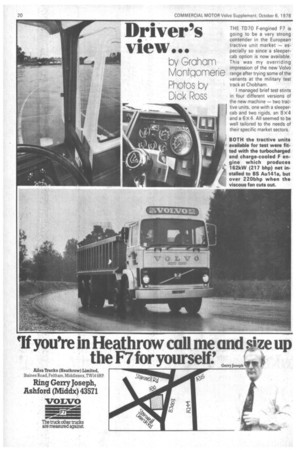Driver's view...
Page 104

Page 105

If you've noticed an error in this article please click here to report it so we can fix it.
THE TD70 F-engined F7 is going to be a very strong contender in the European tractive unit market — especially so since a sleepercab option is now available. This was my overriding impression of the new Volvo range after trying some of the variants at the military test track at Chobham.
I managed brief test stints in four different versions of the new machine — two tractive units, one with a sleepercab and two rigids, an 8x4 and a 6x 4. All seemed to be well tailored to the needs of their specific market sectors.
The increase in power 3ver the old TD7OE engine as certainly very notice3ble especially in mid 'ange and it was also very tractable at low revs. It is lice to be able to report hat an increase in power as not meant an increase n noise level as is so often he case.
It was a pity that both he tractive units had the ;ame power unit as it Nould have made a useful :omparison if one had had :he lower rated G engine — 3x1remely relevant as the 'UK spec" F7 tractive unit s so equipped. vehicle indeed as it would pull strongly from around 900rpm on the level — or rather from around 15 on the rev counter as Volvo has gone for the revs per second approach featured on the larger F10.
All the controls were within easy reach and the visibility was excellent — both front and rear. The superb eight-speed Volvo gearbox and the integral power steering made it very easy for the driver.
The sleeper-version exhibited a completely different ride characteristic to that of the short cab model but I am not sure whether this was due to the larger wheelbase (3.2m compared with 3.0m) or the difference in centre or gravity of the larger cab. The sleeper-cab was far less "bouncy" than the short-wheelbase model.
THE SIX-WHEELER variant was a double-drive model designated the F727 complete with the parabolic spring version of the T-ride bogie. As with the Fl 0 model, the new F7 is a very quiet truck indeed even when the engine is pulling hard. The 6 X 4 was fitted with the 200 horsepower TD70 G engine which gave the F7 a lively performance at 24 tons gross.
One feature which has happily been retained from the long-serving F86 is the excellent eight-speed Volvo gearbox. At this weight the lower two ratios were superfluous when starting off on the level and above this the ratios were well matched to the torque characteristics of the engine. Maximum torque of the G version is just over 500Ibft at 1,400rpm, but the Volvo was quite happy to lug away well below this.
THE EIGHT-WHEELER that I tried was an 8X4. version fitted with a Wilcox tipper body and grossing the full 30 tons. The 8 X 4 is fitted with the R62 box from the F10 and not the R52 box from the F86 and this difference was readily apparent from the driver's seat. Although utilising the same imposed H-pattern range change sequence, the higher spec R62 box was heavier to use. When I say "heavier" it was not excessively so, it was only when compared directly with the R52 version.
Eight-wheelers can be distinctly cumbersome at times, but the power steering and the useful lock of the F7 made it more manoeuvrable than most.


























































































































































